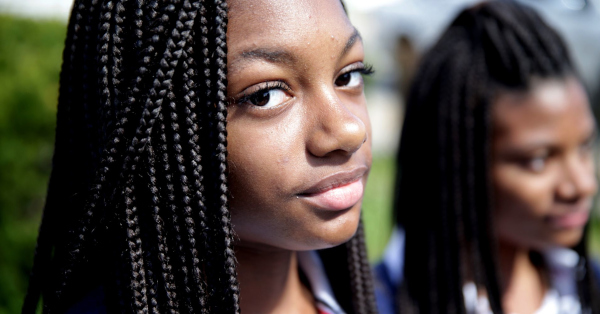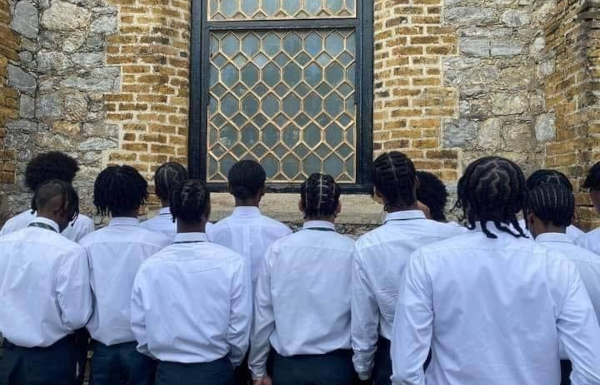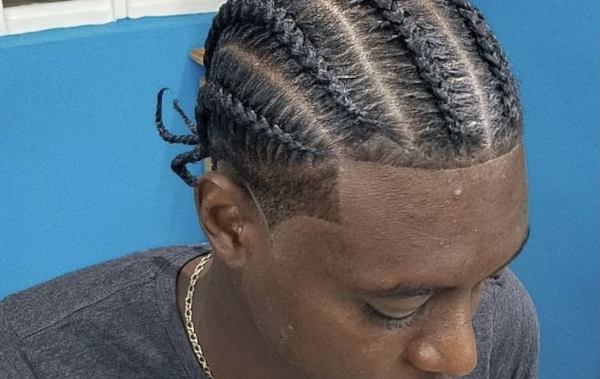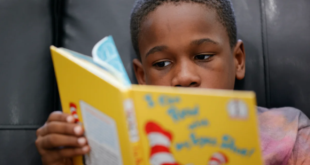The scale of natural justice weighs negatively against the Ministry of Education for allowing 2019 to end without unambiguously prohibiting discrimination against natural African hair texture and basic African hairstyles, and mandating school administrators to root out the practice whenever it rears its ugly head.
Ultimately, it might necessitate amending the Education Act and/or the National School Code of Conduct in keeping with recent progressive State legislation in the USA—legislation puts more power of redress in the hands of victims than mere Ministerial dicta.

(via newsday.com)
The immediate backdrop to this commentary is the allegation of discrimination earlier this year by St Stephen’s College against the 15 year old daughter of Ms Leiselle Morton-Taylor for styling her hair in ‘Bantu knots’.
The alleged incident received headline attention in many mainstream media in the Caribbean Commonwealth, by which I mean the CARICOM arm of the Commonwealth of Nations (formerly known as the British Commonwealth). To date, the issue remains outstanding at the level of government for reasons unknown.
This incident is by no means an isolated one—not even at St Stephen’s, according to Morton-Taylor. African-textured hair-shaming is also not limited to schools or to distinctive styles like Bantu knots, and is certainly not peculiar to female students.
Indeed, it is not a uniquely Trinidad problem. There are well reported cases in other Caribbean Commonwealth states, USA, Latin America and, shockingly, across the African continent as well. I believe it is important to understand how we got to this place.
We could trace this particular evil over the past 1,600 years. Suffice it to say in this commentary, however, that over those centuries, Talmudic-Christian racist theologians, scientific racists from the eighteenth century onward, and European enslavers and colonisers, have striven relentlessly and systematically to imbue African natural hair with intellectual, spiritual and cultural negativity.

The original objective was simply to supplant the artistic representation of the iconic black Madonna-and-Child legacy of Ancient Egypt with a Caucasoid Mary-and-Jesus equivalent of Roman Christianity. European dependence on Africans for the success of their western-hemispheric economic enterprise, launched in the fifteenth century, created a greater imperative for them to induce in African peoples deep feelings of racial inferiority, to such an extent that they would acknowledge their natural hair as abhorrent and subversive of European-defined norms of beauty, decency, attractiveness and tidiness.
For the African, particularly the woman, this was a steep fall from grace. Ancient Africans believed that cranial hair, being the uppermost part of their body, was a receptor to the gods.
Dermatologist, Dr Neil Persadsingh, writes: “The ancient African woman wore her hair with pride. It was common for her to have her hair looked after in a grand manner.”
Fortunately, we still have examples of this artistry in hair in many parts of the continent. As in most cultures, the African woman’s hair defined and enhanced her sexuality; it also depicted her marital status and ethnic identity.
It is not difficult to see how colonial demonisation of the rich tradition in African hairstyles from wide swathes of the continent amounts to ‘culturecide’.

Culturecide is the systematic destruction of a people’s culture by another group for political domination and economic exploitation. It is one of the worse evils inflicted upon the survivors of the European Atlantic slave trade and their descendants. It is a primary cause of psychological disempowerment of Africans in every sphere of life in this part of the world.
One of the primary means of culturecide was the deployment of iconography under missionary Christianity: images of the divine and the saintly were all Caucasoid. The religious assault was reinforced by the promotion of tropes of freedom, economic success and social acceptability with ‘light’ skin and ‘good’ hair—long and straight or near straight.
The advancement of these myths as self-evident truths entrenched the psychosomatic equation of ‘bad hair’ and natural African hair texture, popularly described as woolly, natty, nappy, coily, kinky, picky, and matted, among other demeaning and derogatory terms.
For generations, we participated blindly in reinforcing these tropes of disempowerment at a subliminal level by indulging our babies and young children with Caucasoid dolls and assailing them with bedtime stories populated only by Caucasoid characters, real and fictional.
Such stories had no place for a hero or heroine with ‘dada’ hair. By inadvertently subscribing to these tools of white supremacy we also contributed to the subversion of the revered term, ‘dada’, which was added to the list of demeaning descriptions of natural African hair.

Dada is the Yoruba term for dreadlocks. Rastafarians have a long history of persecution for their dread hairstyle. Discrimination against students with dreadlocks continue in our schools to the present.
A Yoruba child born with locks, however, is considered a divine gift to the community and is given special treatment in traditional religious settings. The oldest African dreadlocks are depicted in the rock art of the Sahara desert, with dates of over 7,000 years. Similar dreadlock styles were worn by Queens and deities of Ancient Egypt. Among the Akan of Ghana, the Akomfo priesthood wore dreadlocks called mpese.
Whether or not the Ancients of Africa spread dreadlocks around the world, beginning some 50,000 years ago, is debatable. What is not debatable is that the same mysticism and sacredness of African-styled dreadlocks are evident among cultures with deep African historical continuities in the Mediterranean, India, Australia, the Pacific Islands and the Americas.
The attack on Bantu knots is similar to the assault on dada hair. If we do not push back with greater force, another historic African hair style will surely be added to the list of demeaning terms mentioned earlier. The word Congo went through a similar process: from flagship of the great kingdoms south of the Equator to a description of contempt.
Just as ignorance is functional to mental enslavement, so is knowledge essential to the liberation of the mind.

Bantu knots have been around for thousands of years in West Africa, as evidenced in Nok terracotta figurines dating back to 500 BC. Bantu knots are also distinctively portrayed in Iron Age Yoruba and Benin bronze sculptures. All these cultures are located in modern-day Nigeria.
The word Bantu could be a personal name, as in Steve Bantu Biko, the founder of the Black Consciousness movement in South Africa during the 1970s.
Until very recently, however, the term ‘Bantu’ was mostly encountered as a linguistic term originating in mid-nineteenth century that now to describe indigenous languages of most of Africa south of the Equator: from Cameroons on the Atlantic coast to the southern border of Somalia on the Indian Ocean coast; from Lake Chad in the north to Cape of Good Hope in the south. Excluded from this group are the indigenous Khoisan vernaculars of Namibia, Zambia and western South Africa.
The teacher involved in the St Stephen’s College incident could have earned the respect of her students by explaining some positives about the word Bantu. Women who sport the Bantu knots may not be aware that Bantu-speaking peoples are celebrated for many firsts in the southern half of Africa, and even in the wider world.
Based on material evidence, the Swazi or their predecessors of the Lebombo Mountains of Swaziland are credited with the oldest application of mathematical numbers, the Lebombo Bone, dated 35-40,000 years old.

Evidence of a much more advanced mathematics, dated 20,000 years ago, was also associated with a Bantu-speaking group in modern-day Democratic Republic of Congo (DRC). Another Bantu group, the Haya of Tanzania, are known to have pioneered the most advanced steel-making technology of the time, some 2,000 years ago.
The Shona of Zimbabwe built the amazing monumental stone structures called Ancient Zimbabwe or Monomotapa after 1200 AD; and the Bantu of the Bunyoro Kingdom of modern day Uganda were highly skilled surgeons who carried out successful caesarean deliveries independent of any foreign medical influence—and long before the procedure was known to most of the world.
The European Atlantic slave trade took a heavy toll on Bantu civilisations. More than one-half of the African captives shipped across the Atlantic in chains between 1502 and 1866 originated in Bantu-speaking Africa, mostly from the Kingdom of Kongo, Angola, Cameroon and their hinterlands.
The renaissance of Bantu knots is a powerful reaffirmation of pride in one’s African identity. Such re-affirmation is a powerful mechanism of self-repair of the psychological damage of self-hate induced from racist association of ‘good hair’ with European hair, and ‘bad hair’ with African hair texture.
It is also a rejection of the vulgar, parasitic exploitation that sustains the economics of hair processing and hair extensions aligned to Europeanised version of female attractiveness and beauty.

The relevance of broadening the discussion on the St Stephen’s College incident is that legislation outlawing discrimination against African hair texture and hairstyles—as many civil rights advocates have demanded—may be necessary; but legislation will be hopelessly inadequate to liberate us from the psychosis of self-hate without knowledge and appreciation of Africa’s rich symbolic cultures.
In Part two of this commentary, I will examine how law potentially facilitates discrimination as well as provides a means of redress. I will also look at possible solutions to the problem of discrimination against traditional African hairstyles in schools, using the Nigerian model.
Editor’s Note: Click HERE to read Part Two of Dr Claudius Fergus’ column on African hair.
Claudius Fergus is a retired Senior Lecturer in the Department of History at UWI’s St Augustine Campus who specialises in the abolition of British colonial slavery and its transatlantic slave trade.
His major work on the subject is Revolutionary Emancipation: Slavery and Abolitionism in the British West Indies (2013). He has other extensive publications in peer-reviewed journals and edited books.
 Wired868 Wired868 for smart sport news and opinion
Wired868 Wired868 for smart sport news and opinion






Most excellent piece. I am still unable to understand why this was an issue in the first place, in 2019. I hopein 2020 it will not be. It is akin to the ban on person wearing the raksha (red/yellow cotton thread on their wrists) that is ritually wrapped around the wrist by Hindus and indicative of a cosmic unity and much more. I recall as a child reading in the newspaper about a Christian church in Laventille refusing an African person. I believe it was communion” just because he had an African name. It is really child abuse and culturecide as you put it (I like the word). We need to continue the firght to decolonize the minds of our people. I fully support you in this exercise. May the new year bring some enlightenment to the colonized mind of the TT citizen.
Enlightenment in the new year? Surely you jest! The decade is unlikely to suffice. How about a light year?
I LOVE this article. I have been an educator for 23 years and have met this attitude several times. I have seethed —sometimes in silence, sometimes aloud. Thank you for the lesson. Hope the teachers in offending schools read this. The shackles of slavery are still mind numbingly tight.